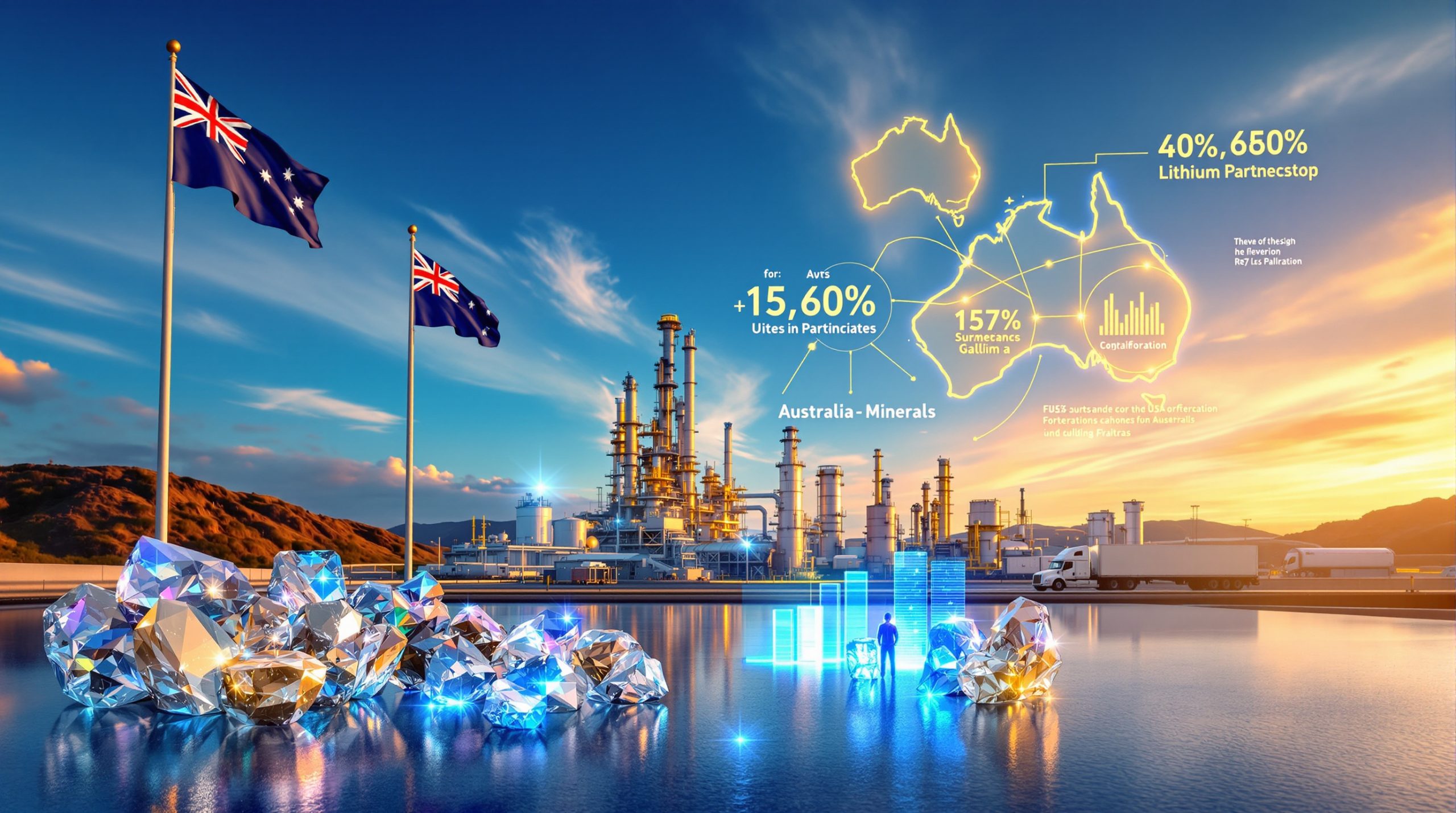Is Lithium Rebounding? Market Signs Point to Recovery After Three-Year Slump
The lithium market has experienced a dramatic decline since its peak in 2022, but recent data suggests a potential turnaround may be underway. After plummeting nearly 90% from its highs, prices have begun showing signs of recovery in mid-2025. For investors and industry participants, the critical question remains: Is lithium rebounding for real this time?
What Caused the Lithium Market Crash?
The Perfect Storm of Oversupply and Demand Slowdown
The lithium market experienced a dramatic decline from its 2022 peak, when prices reached approximately A$6,000/mt. By June 2025, prices had plummeted to four-year lows of US$610/t, representing a staggering 90% drop. This collapse resulted from multiple converging factors creating perfect market conditions for a price crash.
The rapid capacity expansion by producers globally coincided with slower-than-expected electric vehicle adoption rates in Western markets. Meanwhile, substantial inventory buildup throughout the supply chain created a significant oversupply situation that the market couldn't absorb quickly enough.
How Chinese Production Flooded the Market
Chinese producers played a particularly significant role in the market oversupply, aggressively expanding their lithium processing capacity between 2022-2024. This domestic production increase wasn't happening in isolation – it occurred alongside substantial imports from emerging producers in Africa and South America.
The combined effect created a supply glut that pushed prices down to levels where many operations became economically unviable. Chinese capacity expansion wasn't just about volume; it also included technological improvements that allowed processors to handle lower-grade resources more efficiently, further pressuring high-cost producers elsewhere.
What Are the Signs of a Lithium Market Recovery?
Recent Price Movements Show Positive Momentum
Recent market data indicates a potential recovery underway in the lithium sector. CIF China prices for 6% concentrate have risen to $945-955/mt, while other sources report prices between $778-858/mt. Though still far below the 2022 peak, these figures represent a significant improvement from June's four-year lows.
The upward trajectory suggests market sentiment may be shifting from bearish to cautiously optimistic. Price movements have been accompanied by increased trading volumes, particularly in Chinese spot markets, indicating genuine buyer interest rather than speculative activity.
Supply Rationalization Is Finally Taking Effect
The market is experiencing meaningful supply rationalization as unprofitable operations shut down:
- Multiple Australian mines including Bald Hill and Ngungaju have suspended operations
- High-cost Chinese operations have scaled back production significantly
- Zimbabwe projects have reduced output in response to low prices
- A significant mine closure in China due to licensing issues has removed approximately 3-8% of global lithium supply
This supply discipline is creating the conditions necessary for price recovery, with lithium carbonate futures in China responding positively, climbing 1.8% to 8,000 yuan/ton. The market appears to be entering a more balanced state after years of oversupply.
Chinese authorities have also implemented stricter enforcement of mining permits, specifically targeting operations contributing to oversupply conditions. This regulatory approach represents a strategic shift that could provide longer-term support for price stability.
How Strong Are the Demand Fundamentals?
EV Market Growth Continues Despite Headwinds
While EV adoption rates have slowed from their earlier explosive growth, the overall trajectory remains positive. China continues to lead global EV adoption, with steady growth in Europe and North America. Analysts project lithium demand growth of approximately 26% in 2025, reaching 1.46 million tonnes of lithium carbonate equivalent (LCE).
BYD's rising popularity in the electric vehicle market has reignited investor attention toward the EV sector's long-term potential. The company's success demonstrates that consumer preferences are increasingly favoring electric models, supporting fundamental demand for lithium batteries.
| Region | EV Sales Growth (YoY) | Market Penetration |
|---|---|---|
| China | 18-22% | 31% |
| Europe | 12-15% | 24% |
| North America | 15-18% | 10% |
| Global Average | 16-20% | 19% |
Diversified Demand Sources Strengthen the Outlook
Beyond EVs, additional demand sources are emerging that provide resilience to the lithium market:
- Grid-scale energy storage systems deploying at accelerated rates
- Robotics and automation technologies requiring high-performance batteries
- Consumer electronics with larger batteries and longer lifecycles
- Industrial applications expanding beyond traditional uses
This diversification creates a more resilient demand profile less dependent on a single sector, potentially reducing future market volatility. Energy storage deployments in particular are growing at over 30% annually, creating significant new lithium demand that wasn't fully factored into earlier market projections.
How Are Companies Positioning for the Recovery?
Operational Strategies Reflect Cautious Optimism
Mining companies are implementing strategic plans in anticipation of market improvement:
- Core Lithium has unveiled a restart plan for its mothballed project, with improved margins and an increased resource estimate of 48.5Mt @ 1.26% lithium
- Major players like Rio Tinto, Albemarle, SQM, and Ganfeng are pursuing M&A opportunities and operational efficiencies
- Cost reduction initiatives are widespread across the sector, with producers focusing on lowering break-even points
- Innovative processing technologies are being deployed to improve recovery rates and reduce operating expenses
These actions indicate industry confidence in an eventual market recovery, though timing remains uncertain. Companies appear to be positioning for a multi-year upswing rather than a quick return to peak prices.
Investment Activity Shows Renewed Interest
Market participants are showing signs of renewed interest in the lithium sector:
- Some fund managers, including Argonaut and Ten Cap, have reportedly taken positions against short-sellers
- Analysts from major financial institutions, including CBA's Vivek Dhar, have begun calling the bottom of the market
- Capital raising activities for lithium projects have seen improved investor reception
- Strategic investments by automakers seeking to secure supply chains are increasing
This renewed investment interest suggests growing confidence that the worst of the downturn may be over. However, the investment community remains cautious, with most participants waiting for clearer signals before making major commitments.
Why Should Investors Remain Cautious?
Supply Disruptions May Be Temporary
While recent supply disruptions have helped prices recover, there's uncertainty about their longevity. The Chinese mine shutdown that sparked the recent rally could potentially be reversed if licensing issues are resolved. Analysts generally expect a more sustainable recovery in 2026 rather than immediately.
Commodity market bottoms typically involve a multi-month base-building phase, sometimes with price retests before a stronger uptrend emerges. History suggests that premature enthusiasm about price recoveries can lead to disappointing investment outcomes.
Inventory Levels Remain Elevated
Despite production cuts, significant inventory overhang persists throughout the supply chain:
- China's chemical inventories have increased by approximately 35,000 tonnes since January 2025
- This inventory buildup must be absorbed before a sustained price recovery can take hold
- The market is still projected to have a modest surplus in 2025, with a potential transition to deficit only by 2026
| Inventory Category | Current Level | Change vs. 12 Months Ago | Months of Supply |
|---|---|---|---|
| Raw Material | Elevated | +25% | 3.2 |
| Chemical Intermediates | High | +35% | 2.8 |
| Refined Products | Moderate | +10% | 1.9 |
These inventory levels represent a substantial headwind that must be worked through before prices can sustain higher levels. The timeline for this inventory reduction depends on both production discipline and demand growth.
Price-Sensitive Supply Could Quickly Return
If prices stabilize or recover significantly, idled capacity could quickly restart:
- Projects like Core Lithium's Finniss operation could resume production
- Producers in regions like Zimbabwe, Nigeria, and China could re-enter the market
- This elastic supply response could cap price recovery
Many operations that have been temporarily suspended maintain their equipment and permits, allowing for rapid restart once economics improve. This creates a ceiling effect for prices until demand growth can absorb both existing inventory and potential returning supply.
Alternative Investments Remain Attractive
Investor capital that exited lithium has found homes in other commodities, particularly gold. For lithium to attract significant investment flows back from safe-haven assets would require compelling evidence of a sustained recovery, not just short-term price movements.
Gold's historical role as a hedge against economic uncertainty has strengthened its appeal during lithium's downturn. Without a dramatic shift in broader economic conditions or a substantial acceleration in lithium demand, this capital reallocation may be slow to reverse.
What Are Customers and Partners Signaling?
Mixed Signals from End Users
Recent developments from lithium customers and joint venture partners present a mixed picture:
- Liontown reported that US automaker Ford has reduced its committed purchase volumes
- IGO fully impaired its stake in the Kwinana lithium hydroxide facility
- Most producers with restart plans have not committed to specific timelines, preferring to wait for sustained price improvement
- Cost reduction remains a primary focus across the industry
These signals suggest caution among major industry participants despite the recent price improvements. Battery manufacturers and automakers appear to be adopting a wait-and-see approach before making significant new commitments to lithium purchases.
"While we're seeing some positive price momentum, customers remain hesitant to lock in long-term contracts until they see clear evidence of sustained market recovery. The psychology of the market remains cautious after experiencing such dramatic price volatility." – Industry analyst
What Price Level Would Confirm a New Bull Market?
The US$1,000/mt Threshold
Market analysts suggest that sustained prices above US$1,000/mt would provide stronger evidence of a new bull market in lithium. This level would support the economics of many currently idled operations and potentially trigger restart decisions. Until prices reach and maintain this threshold, the recovery remains tentative.
This price point is particularly significant because it represents a level where approximately 60-70% of global production capacity can operate profitably. Sustained trading above this level would indicate a fundamental shift in market dynamics rather than a temporary fluctuation.
Watching for Sustained Demand Growth
Beyond price levels, investors should monitor EV sales growth rates, particularly in China, Europe, and North America. Accelerating adoption would provide fundamental support for higher lithium prices. Additionally, energy storage deployment trends will offer insights into the diversification of lithium demand beyond the automotive sector.
Key metrics to watch include:
- Monthly EV sales figures in major markets
- Battery manufacturing capacity utilization rates
- Grid-scale energy storage project announcements
- Consumer electronics replacement cycles and battery capacity trends
Positive momentum across these indicators would suggest a robust foundation for sustained lithium price recovery.
How Should Investors Approach the Lithium Sector?
Selective Positioning Based on Cost Structure
Not all lithium producers are created equal. Companies with low-cost operations, strong balance sheets, and strategic partnerships are better positioned to weather continued volatility and capitalize on the eventual recovery.
Investors should focus on producers with:
- First or second quartile cost positions
- Diverse customer relationships beyond a single geography
- Financial strength to withstand further market weakness
- High-quality resources with favorable mineralogy
- Clear path to value-added products rather than just raw materials
These characteristics provide resilience during market uncertainty while offering significant upside potential when prices recover more substantially.
Balancing Opportunity with Risk Management
While signs of recovery are emerging, the lithium market remains volatile. A balanced approach might include:
- Establishing initial positions in quality producers with strong balance sheets
- Maintaining cash reserves for potential market pullbacks
- Diversifying across the battery materials supply chain
- Setting clear price targets for both entry and exit
- Focusing on companies with multiple potential catalysts beyond just lithium price recovery
This measured strategy acknowledges the potential for continued market volatility while positioning for long-term sector growth. Furthermore, investors might consider keeping an eye on Australia lithium innovations which could significantly impact production costs and efficiency.
FAQs About the Lithium Market Recovery
Will lithium prices return to 2022 peak levels?
Most analysts consider the 2022 price spike an anomaly driven by supply chain disruptions and panic buying. While prices are expected to recover from current lows, a return to those extreme levels is unlikely in the near term. A more sustainable price range of $1,000-2,500/mt appears realistic based on cost curves and demand projections.
How are Chinese EV sales affecting lithium demand?
Chinese EV sales continue to grow, though at a more moderate pace than in previous years. The success of manufacturers like BYD has highlighted the ongoing transition to electric mobility, supporting lithium demand fundamentals. China's domestic policies continue to favor EV adoption, providing a solid foundation for lithium demand growth.
What impact will new lithium extraction technologies have?
Direct lithium extraction technologies could potentially increase supply and lower costs, but widespread commercial deployment remains several years away. These technologies are unlikely to significantly impact the market before 2027-2028. Technical challenges and capital requirements for scaling these solutions mean they represent a longer-term evolution rather than an immediate disruption.
How are geopolitical factors influencing the lithium market?
Supply chain security concerns and geopolitical tensions have increased interest in developing lithium resources in politically stable jurisdictions. This could lead to premium pricing for non-Chinese supply in the medium term. Western governments are increasingly supporting domestic battery supply chains, creating potential advantages for producers in those regions. Additionally, India's lithium strategy is emerging as a significant factor in the global market.
Further Exploration
Lithium's position as a critical material for the energy transition ensures its long-term importance, despite current market challenges. The sector's recovery trajectory will likely be influenced by both macroeconomic factors and industry-specific developments in the coming years.
For investors, the current environment offers both risks and opportunities. Those with a longer-term perspective may find value in selectively building positions in quality producers while maintaining appropriate risk management strategies. As with any commodity market, timing will be challenging, but the structural growth story remains intact.
Monitoring key indicators across the supply chain – from mining activity to battery production to end-user demand – will provide valuable insights into the strength and sustainability of lithium's market recovery. In particular, developments in Argentina lithium insights and Thacker Pass production trends can offer early signals of how global supply dynamics are evolving.
According to a recent analysis by S&P Global, while lithium prices are showing signs of recovery, there remains debate about whether the rebound will be sustained in the longer term. Similarly, market observers at Stockhead have questioned if we're finally seeing the end of what they call the "long lithium winter" that has plagued the sector since 2022.
Looking for Early Insights on the Next Lithium Stock Surge?
Discovery Alert's proprietary Discovery IQ model provides real-time notifications on significant ASX mineral discoveries, including lithium, giving you immediate insights into actionable opportunities before the broader market. Visit the Discovery Alert discoveries page to understand how early identification of major mineral finds can generate substantial returns for investors.




